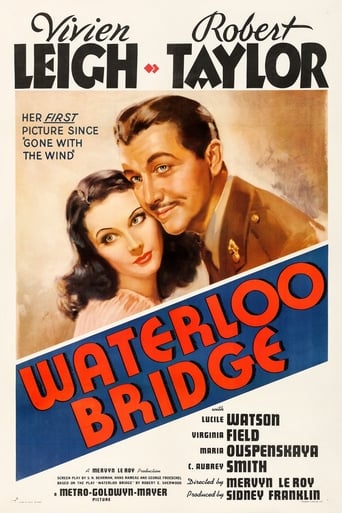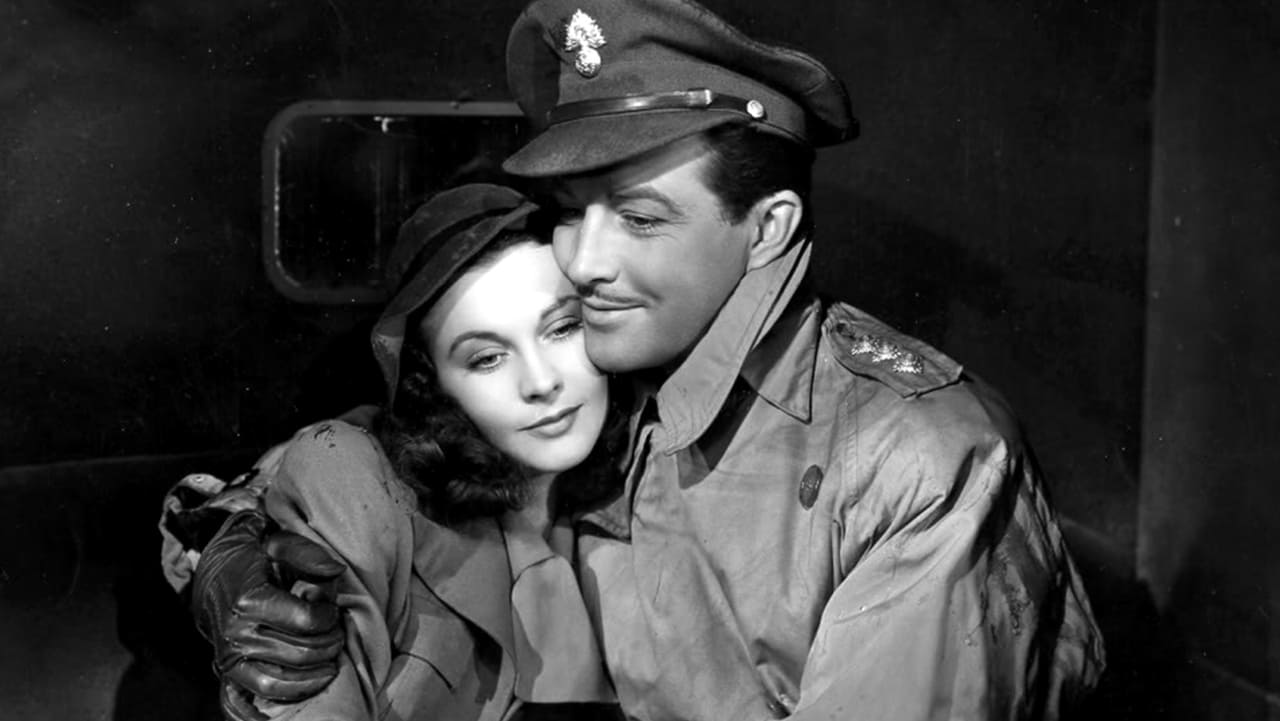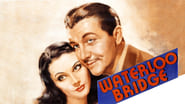jc-osms
I watched this film on the recommendation of a friend and wasn't disappointed. Although the main action is told in an extended flashback set in civilian life during the First World War, the bookending of the movie with Robert Taylor's middle-aged army colonel's long reminiscence on Waterloo Bridge of the love of his life is set in present day 1939 just after the outbreak of World War 2, making it one of the first films reflecting the new, even more devastating conflict. That said seeing the characters in contemporary clothing and hair-styles you might be forgiven for thinking it is a WW2 movie but one shouldn't forget the likely underlying aim of the film to interest and influence the watching American public on the side of the British as they initially stood almost alone against the German Army so perhaps the familiarity engendered was deliberate.There is no military action in the film however although the fact of Taylor's Captain Roy Cronin being an army officer does otherwise play a big part in proceedings, as it's a bomb raid which first throws he and Vivian Leigh's ballet dancer Myra together where they immediately spark and fall in love. Their whirlwind romance sees him attempt to marry her before he's posted overseas in two days only to be thwarted in this by his posting being brought forward a day. An unforeseen consequence of this is that Leigh loses her placing with the ballet corps which employs her, falling foul of the tyrannical old Madame who runs the company for missing a performance by rushing elsewhere to see Taylor off. Although she's accompanied in this departure by her rebellious friend and fellow-dancer Kitty (played by Virginia Field) who resigns herself in support of Leigh, when they find no work elsewhere for either of them, they resort to the oldest profession to survive, becoming streetwalkers, ironically to services personnel. Sure the plotting is highly melodramatic and the ending despairingly sad, but with two excellent star turns, fine supporting work by the rest of the well chosen cast and polished direction by Mervin Le Roy it's a very satisfying entertainment and must have been even more so to its original wartime audience.I've occasionally let my perception of Robert Taylor be clouded by the unsavoury part he played during the Communist witch hunt in Hollywood immediately after the war ended but he's undoubtedly handsome, charming and sincere here while the camera which so loved Leigh in the glorious technicolour of the immediately preceding "Gone With The Wind" continues its affair with her here in black and white. She really did have a most expressive face as we see her character run the gamut of emotions as her fortunes rise and fade time and again.Most impressive for me though was the skill with which it was directed by Mervin Le Roy. As well as helping the film leave behind its theatrical origins and keeping the occasionally improbable narrative going, there are lovely touches of flair exhibited which had me purring with pleasure. Some examples would be the dolly shot which picks out Taylor from the crowd at the train station, another high tracking shot of the pair dancing away from the crowd at a party to a private balcony, the dramatic focus on Leigh's face as she makes her fateful choice on Waterloo Bridge (I wonder if Hitchcock remembered it for Grace Kelly's trial scene in "Dial M for Murder") and the couple's first rapturous, silent dance together by candlelight. There's even a very modern shot with a double close up of Field and Leigh with the one in the foreground out of focus.All in all, a really fine film the like of which as the cliche has it, they don't make anymore.
utgard14
On the eve of World War II, British officer Robert Taylor thinks back to his time in the first World War and his romance with ballerina Vivien Leigh. The second film version of Robert Sherwood's play is a glossy MGM production, which brings with it certain pros and cons compared to the 1931 version made at Universal. For starters, it has first-rate production values. Although it's separated by less than a decade from the other film, the technical aspects of filmmaking had come a long way in a short time. The cast, direction, cinematography, and music score are all excellent. This is a polished, beautiful film with two of the most attractive leads in movie history. Which leads to the main complaint I have about this film. The original Pre-Code film was grittier and seamier, both in terms of its production and its script. The script here was rewritten to make Vivien Leigh's character more 'acceptable' by the standards of the Production Code. This leads to some head-scratching plot points and an ending that is, quite frankly, the film's weakest part. I don't want to give too much away but I'll just say that up until the ending this was one of my favorite romantic movies of all time. If they had just followed the outline of the original story but kept the MGM gloss on the romantic parts, I would score this a ten. As it is with the changes, I have to knock a little off. Still, it's a picture any classic film fan will want to see at least once. Any movie with Maria Ouspenskaya in it is worth a look. It's a prime example of the lovely old-fashioned style of melodrama that MGM excelled at. It's not close to perfect but few movies are.
SHAWFAN
I too was struck by the anachronistic costumes (WWII garb for a WWI story) as well as by the inaccurate depiction of WWI airwars and bomb shelters as noted by one of your reviewers. I thought another reviewer's point well taken as to how did Taylor actually reacquire the little good luck charm after Leigh's death. But Taylor's Americanism as noted by another of your reviewers was accounted for by Sherwood's original play protagonist as actually being an American (himself.) So that we can accept.But I noted too that while your reviewers referred to Sherwood's original 1930 play as well as to the 1931 James Whale original movie version an important predecessor to this story seems to have escaped everyone, namely Arthur Wing Pinero's celebrated play, "The Second Mrs. Tanqueray" (1893). In this play, famous in its time for its faux-realism and its eagerness to put the question of prostitution onto the stage, a lady with a doubtful past likewise aspires to membership by marriage into the aristocracy. But when her past is discovered she too chooses suicide as the only way out. The parallels between SMT and WB struck me immediately. Perhaps WB is even more directly related to SMT than either Sherwood or Whale.Herbert Stothart's score was quintessentially typical. HS' method was usually to take familiar melodies (such as "Auld Lang Syne") and doll them up with fantasy orchestrations. You can usually tell a Stothart score when you hear it.
chrisart7
Very romantic film with fine actors. Robert Taylor is quite American, but it seems that Hollywood intentionally used Americans in films that were supposed to have all (or nearly all) British characters so that American audiences would not find the films too 'foreign.' Some of the supporting characters in Frank Capra's 1936 "Lost Horizon" come to mind, for instance. While Robert Taylor is of ideal stature and appearance in "Waterloo Bridge", a British actor like Ronald Colman would have been a better fit (though he was beginning to get on in years by 1940). Colman did appear in Mervyn LeRoy's "Random Harvest" two years later, and, interestingly, the haunting music of "Swan Lake" makes its way into that film, too. Vivien Leigh does not even seem to be acting in "Waterloo Bridge". It is as if she and the role were one, which is a supreme compliment to an actor. And it is always a pleasure to see a veteran character actor like C. Aubrey Smith, usually cast as blustery (but lovable) curmudgeons---retired generals and the like.



 AD
AD




